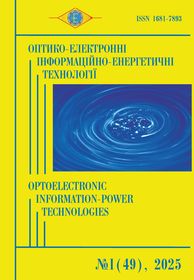Use of neuroheadsets for diagnostics of diseases
DOI:
https://doi.org/10.31649/1681-7893-2025-49-1-168-177Keywords:
neuroheadsets, electroencephalography, neuropsychological disorders, depression, anxiety states, neurofeedback, functional diagnosticsAbstract
The article highlights modern approaches to the use of neuroheadsets in the diagnosis of psychoneurological diseases, including depression, anxiety disorders, epilepsy, schizophrenia, Parkinson's disease, and Alzheimer's disease. The main focus is on the registration and analysis of electroencephalographic signals, which provide a non-invasive assessment of the functional state of the brain. The significance of rhythmic activity of various frequency ranges — in particular, alpha, beta, theta, and delta waves — as markers of certain disorders is revealed. It is shown that depression typically exhibits a decrease in alpha activity in the left frontal cortex, and anxiety disorders typically exhibit an increase in high-frequency beta activity. Changes in the spectral composition of signals in epilepsy are analyzed, in particular, focal disturbances and paroxysmal complexes, which can be recorded using neuroheadsets in clinical or home conditions. The article also provides information on the reduction of coherence and variability of EEG signals in Alzheimer's disease and changes in electrical activity in patients with Parkinson's disease. Considerable attention is paid to the possibility of using neurofeedback technologies within the framework of cognitive and everyday rehabilitation, which are based on the patient's active control of their own electrophysiological reactions. The practical feasibility of using neuroheadsets for the initial screening of the patient's condition, monitoring the dynamics of treatment and assessing the effectiveness of psychotherapeutic and pharmacological approaches is emphasized. As a result, it is concluded that neuroheadsets open up new opportunities for rapid, safe and economically accessible diagnostics of nervous system disorders in a wide range of patients of different ages.
References
Thibault, R. T., Lifshitz, M., Birbaumer, N., & Raz, A. (2020). Neurofeedback, self-regulation, and brain imaging: Clinical science and fad in the service of mental disorders. Psychotherapy and Psychosomatics, 89(4), 193–207. https://doi.org/10.1159/000506832
Bekkedal, M. Y. V., Rossi, J. S., Panksepp, J., & Davis, M. (2021). EEG asymmetry in major depressive disorder: State, trait, or artifact? Biological Psychology, 162, 108093. https://doi.org/10.1016/j.biopsycho.2021.108093
Tavakoli, H., & Motiei-Langroudi, R. (2023). Clinical application of wearable EEG devices in neuropsychiatric disorders: A review. Frontiers in Human Neuroscience, 17, 1122334. https://doi.org/10.3389/fnhum.2023.1122334
Mehta, R., Bajaj, H., & Roy, D. (2022). Machine learning for mental health in neurophysiology: EEG-based classification of anxiety and depression. IEEE Transactions on Neural Systems and Rehabilitation Engineering, 30, 980–991. https://doi.org/10.1109/TNSRE.2022.3170198
Krigolson, O. E. (2018). Event-related brain potentials and the study of decision making: A brief review. Brain Sciences, 8(8), 132. https://doi.org/10.3390/brainsci8080132
Casson, A. J. (2019). Wearable EEG and beyond. Biomedical Engineering Letters, 9, 53–71. https://doi.org/10.1007/s13534-019-00096-2
Abiri, R., Borhani, S., Sellers, E. W., Jiang, Y., & Zhao, X. (2019). A comprehensive review of EEG-based brain–computer interface paradigms. Journal of Neural Engineering, 16(1), 011001. https://doi.org/10.1088/1741-2552/aaf12e
Dauwels, J., Vialatte, F., & Cichocki, A. (2017). Diagnosis of Alzheimer’s disease from EEG signals: Where are we standing? Current Alzheimer Research, 14(4), 394–408. https://doi.org/10.2174/1567205013666161222143701
An, D., Fahoum, F., & Gotman, J. (2017). Detection of focal epileptic seizures using scalp EEG and advanced signal processing. Clinical Neurophysiology, 128(6), 958–968. https://doi.org/10.1016/j.clinph.2017.03.008
Ibrahim, A., & Majid, M. A. (2020). Brain–computer interface for Parkinson’s disease patients: A systematic review. IEEE Access, 8, 185146–185157. https://doi.org/10.1109/ACCESS.2020.3029941
Niedermeyer, E., & da Silva, F. L. (Eds.). (2020). Electroencephalography: Basic principles, clinical applications, and related fields (7th ed.). Oxford University Press.
Shevchuk, I. M., & Kozlovska, I. S. (2023). Prospects for the use of neurotechnologies in the diagnosis of mental disorders. Ukrainian Journal on Problems of Medicine and Biology, 28(4), 25–31.
Dyachenko, V. Yu. (2022). Biofeedback technologies based on brain activity: Diagnostic capabilities. Scientific News of NTUU "KPI", 4, 47–52.
Lavreniuk, O. P., & Reznik, S. V. (2021). Electroencephalography in psychological diagnostics practice. Psychology and Society, 2, 119–125.
Maidaniuk, V. P., & Romaniuk, O. N. (2025, March 24–27). Non-invasive brain–computer user interface. In Proceedings of the LIII All-Ukrainian Scientific and Technical Conference of the Departments of Vinnytsia National Technical University (2024) (Vinnytsia, Ukraine). https://conferences.vntu.edu.ua/index.php/all-fitki/all-fitki-2025/paper/view/23517/19471
Grand View Research. (2024). Wearable EEG headsets market to reach USD 244.9 million by 2030, growing at a CAGR of 10.4% [Press release]. https://www.grandviewresearch.com/
Pavlov S. V. Information Technology in Medical Diagnostics //Waldemar Wójcik, Andrzej Smolarz, July 11, 2017 by CRC Press - 210 Pages.
Wójcik W., Pavlov S., Kalimoldayev M. Information Technology in Medical Diagnostics II. London: (2019). Taylor & Francis Group, CRC Press, Balkema book. – 336 Pages.
Downloads
-
PDF (Українська)
Downloads: 64
Published
How to Cite
Issue
Section
License
Автори, які публікуються у цьому журналі, погоджуються з наступними умовами:- Автори залишають за собою право на авторство своєї роботи та передають журналу право першої публікації цієї роботи на умовах ліцензії Creative Commons Attribution License, котра дозволяє іншим особам вільно розповсюджувати опубліковану роботу з обов'язковим посиланням на авторів оригінальної роботи та першу публікацію роботи у цьому журналі.
- Автори мають право укладати самостійні додаткові угоди щодо неексклюзивного розповсюдження роботи у тому вигляді, в якому вона була опублікована цим журналом (наприклад, розміщувати роботу в електронному сховищі установи або публікувати у складі монографії), за умови збереження посилання на першу публікацію роботи у цьому журналі.
- Політика журналу дозволяє і заохочує розміщення авторами в мережі Інтернет (наприклад, у сховищах установ або на особистих веб-сайтах) рукопису роботи, як до подання цього рукопису до редакції, так і під час його редакційного опрацювання, оскільки це сприяє виникненню продуктивної наукової дискусії та позитивно позначається на оперативності та динаміці цитування опублікованої роботи (див. The Effect of Open Access).


